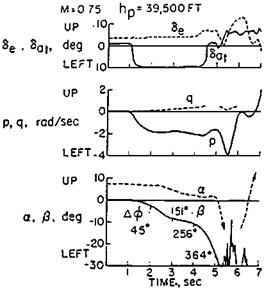The 1956 Wright Field Conference
When inertial coupling first appeared on the scene with the Douglas X-3 research airplane and then the F-100A Super Sabre, interest in the subject grew quickly among those responsible for fighter airplane stability and control. Although first-line fighter flight test results were classified either confidential or secret, the grapevine was hard at work, and information started to circulate on this new potential for uncontrolled maneuvers and structural failures.
U. S. Air Force and Naval engineerssaw the need for groupsgrappling with the unexpected inertial coupling problem to convene and exchange information for the common good. A closed-door, classified conference was therefore called at Wright Field for February 1956. Papers were invited from industry, NACA, and MIT. Because of the urgency and national importance of the subject, authors and attendees from industry were expected to give open accounts of their results, putting aside competitive considerations.
The list of speakers at the since-declassified Wright Field Conference, formally called “Wright Air Development Center Conference on Inertia Coupling of Aircraft,” included many of the important stability and control researchers and designers of fighter aircraft of that period:
They were: Robert Bratt and Charles DaRos of Douglas; Frederick Curtis, Mamoree Masaki, and Dewey Mancuso of Convair; John Gautraud, James Flanders, Thomas Parsons, and Lloyd Wilkie of MIT; Richard Heppe of Lockheed; Wayne Huff and Cecil Carter of Chance Vought; Henry Kelley, Hans Hinz, and Robert Kress of Grumman; Darrel Parke of McDonnell; Jerry Pavelka of Republic; Stanley Schmidt, Norman Bergrun, Robert Merrick, Leonard Sternfield, Joseph Weil, and Richard Day of NACA; and John Wykes of North American.
Charles Westbrook chaired the conference and edited the proceedings (Westbrook, 1956). The lively interest in inertial coupling brought no fewer than 184 conference attendees. This conference on a serious stability problem held in the halls of their chief customer brought out
|
Figure 8.5 Time history of a classic inertial coupling example. The YF-102 diverges to a negative angle of attack and left (negative) side-slip angle in a rapid roll. (From Weil, WADC Conf. 56WCLC-1041, 1956) |
a certain defensiveness in the speakers from industry. No blanket criticism is now intended, since it is understandable that airplane designers should want to put their products in the best light. Still, the transcript shows statements such as these:
In all of these [roll] tests the airplane response has been normal to the pilot and safe from every flight standpoint.
… serious difficulty due to inertial coupling is not to be anticipated for the——— .
…. the generally satisfactory roll behavior of the airplane was most welcome….
These benign, reassuring words were accompanied by hair-raising simulation and flight records, in several cases, such as the Convair YF-102 (Figure 8.5).












